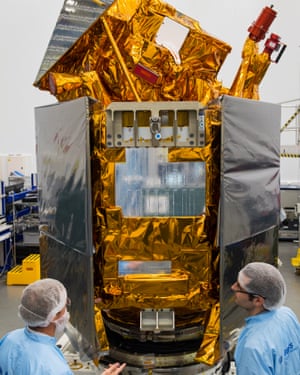UK-built pollution monitoring satellite ready for launch
Last year, the European Space Agency launched the Trace Gas Orbiter to Mars. It is designed to look for methane – a key tracer of life – to determine if Martian microbes are present on the red planet.
Now, ESA is preparing to launch another spacecraft to look at methane on another planet: our own.
The UK-built Sentinel-5P, a pollution monitoring satellite, is ready to begin its journey from Airbus Defence and Space, Stevenage, to the Plesetsk Cosmodrome, Russia, where it will lift off in late September/early October.
Sentinel-5P is part of the Copernicus global monitoring programme, a joint venture between the European Commission and the European Space Agency. This particular spacecraft is the first Copernicus satellite dedicated to monitoring atmospheric chemistry.
Missions like this are essential for making the connection between space and everyday life on Earth, according to Colin Paynter, Managing Director of Airbus Defence and Space, UK. He says, “Space is not just for geeks, it is part of our national and international infrastructure.”
As a greenhouse gas, methane is potent. It traps 28 times more heat than an equivalent mass of carbon dioxide. It is released naturally by living things – hence the interest in looking for it on Mars – but also from the fossil fuel industry, landfill sites, rice agriculture and the thawing of the permafrost at higher latitudes.
As well as methane, Sentinel-5 P will also look for nitrogen dioxide and other key polluting gases.
Nitrogen dioxide comes mainly from road traffic and other fossil fuel combustion, and naturally occurring forest fires. Last year a report from the Royal College of Physicians and the Royal College of Paediatrics and Child Health found that in the UK air pollution causes at least 40,000 deaths a year, and costs the economy £20bn a year.
Sentinel-5P will be able to measure pollution accurately across individual countries, which can then be compared to their self-declared pollution inventories. It will image the whole Earth every day, and can also monitor concentrations of volcanic ash for air safety, and warn against high levels of the UV radiation that can cause skin cancer.
The Copernicus programme aims to provide comprehensive Earth observation data to improve the management of the environment. It will eventually consist of 20 missions, 15 of which will be dedicated satellites and 5 of which will be instruments on other spacecraft.
“A system like this has never existed before,” says Josef Aschbacher, Director of Earth Observation Programmes, European Space Agency. “The US and other partners are looking to Europe to make deals to get access to this data.”
In a statement released today, business secretary Greg Clark said, “The UK-built Sentinel-5 Precursor satellite and the success of the Copernicus Programme demonstrates what we can achieve through collaboration with our European partners and the UK’s vital role in the programme thanks to our Earth observation expertise.”
Aschbacher confirms that the UK has been a strong partner and says that from a programme management point of view, he wants to see that role continue but, “Brexit is the thing that is floating above us.”
Although the UK will remain a member of ESA, around 70 percent of the Copernicus programme is funded from the European Commission. As such, Britain’s future involvement seems certain to be affected by the Brexit settlement.
“It is clearly important to our industry to stay a part of the programme,” says Graham Turnock, Chief Executive, UK Space Agency, “We cannot wait until the day before Brexit to get clarity on this.”
Separately, the future of the Copernicus programme is part of an on-going series of negotiations between ESA, its member countries and the European Commission. Aschbacher says that such constant reappraisal is essential, “We have the best system in the world. In 10 years, I want to ensure that we still have the best system in the world.”
The next major hurdle is an ESA Ministerial Meeting in late 2019, after the UK has left the EU. Here, each country will agree how much to contribute to Copernicus and each of the space agency’s other programmes.
The Sentinel-5P mission is designed to last for seven years in an 824km-altitude orbit around the Earth. No one knows where the UK will be in its orbit around the EU in 2024.
Stuart Clark is the author of The Search for Earth’s Twin (Quercus). He will be delivering the Guardian masterclass on Is there life beyond Earth? on 6 September 2017.




Post a Comment